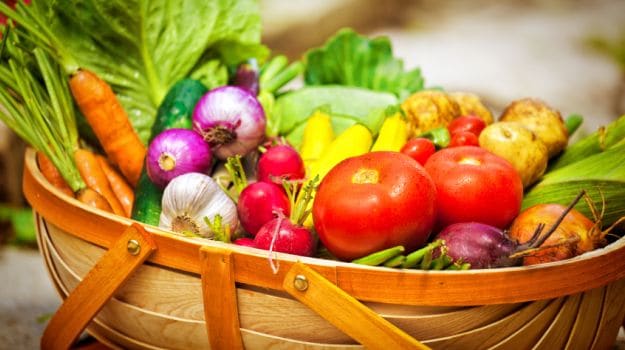India's Phytonutrient Report, a new publication by the Indian Council for Research on International Economic Relations and the Academic Foundation, reveals that Indians across age groups and income categories are falling short in meeting the World Health Organisation's (WHO) recommended daily intake of five servings of fruit and vegetable.According to these findings, we're only consuming 3.5 servings of fruit and vegetables per day and by doing so, we're exposing ourselves to the risk of predisposing themselves to chronic diseases, the reason why the WHO issued that guideline. Rapid spread of fast food joints, long work hours and the rising prices of fruit and vegetable are the leading reasons for a drop in their consumption.India has the greatest burden of lifestyle diseases in the world which is accentuated by an inefficient public-healthcare system, IndiaSpend reported. Healthcare expenses push an additional 39 million people back into poverty every year, a Lancet paper recently notified. While investigating the causes for the increasing prevalence of chronic diseases globally in the 1980s, the WHO zeroed in on dietary changes. Most developed nations and the affluent in developing nations were eating less fruits, vegetables and whole grains, and more of fat, processed food and sugar than earlier generations.
India faces a similar scenario. A 1991 WHO study concluded that affluent Indians were getting 30 percent of their daily energy intake from fats and were consuming half the amount of dietary fibre than previous generations. To stop the spread of chronic diseases, the WHO had recommended eating at least 400 grams - five servings of 80 gm each of fruit and vegetables in a day. Indians have largely ignored that warning and this poor dietary choice is showing up in the mortality data.In the last quarter century, chronic diseases have emerged as the number one cause of death in India. Heart disease has become India’s top killer, IndiaSpend has reported. Moreover, India is also facing a diabetes epidemic, with about one in 10 adults suffering from the disease and more than a million succumbing to it annually. Cancer has become India’s fourth major killer, doubling its presence since 2004, IndiaSpend has reported. With such grim statistics, why have we been ignoring such a crucial warning? As per the report, high costs primarily keep Indians from consuming enough fruit and vegetables. The prices of fruit and vegetable rose steadily over the last decade, with most prices doubling, even trebling in the case of some vegetables like sweet potato and ginger.Rising food prices affect low-income families the most but the middle class is not exempt. The price of fruits and vegetables was the third most frequently cited reason for the low consumption of fruit and vegetables, as stated in the Phytonutrient Report. Correspondingly, higher earners in the five cities - Chennai, Kolkata, Hyderabad, NCR and Mumbai were found to consume more fruit and vegetables."Most of the respondents from Chennai and Hyderabad were vegetarian and from higher income families, which is possibly why we found a higher intake of fruits and vegetables in those cities,” said Arpita Mukherjee, professor, Indian Council for Research on International Economic Relations, and the studyÂ’s lead author.The study found that vegetarians consumed 3.97 servings of fruit and vegetables while non-vegetarians included 3.2 servings in their daily diet. Most young adults and students prefer fast food over fruits and veggies. Young adults aged 18 to 25 and students eat roughly three servings of fruit and vegetables compared to 3.5 helpings that adults consume, according to the Phytonutrient Report. More middle-class Indians are eating fast food instead of sabzi-roti-dal-chawaland in the process, limiting their intake of fruit and vegetables. In smaller cities and towns, middle-class households doubled spending on food between 2012 and 2014, the 2014 Assocham paper Indian Fast Food Market New Destination: Tier-II & III Cities tells us. In metropolitan cities, middle-class households increased spending on fast food by 35% over the same period.Five-a-day is a catchphrase coined to popularize the WHO recommendation. India, like Germany, Holland and New Zealand, endorses the five-a-day recommendation but other countries recommend more helpings of fruit and vegetables and studies have also shown that you should add more fruits and vegetables to your daily diet. Five portions a day are good for children, according to Canadian guidelines. But teens and adults need seven or more servings of fruit and vegetables. Five servings of vegetables and two of fruit is the Australian guideline, based on the belief that vegetables do more good than fruit.Last year, a British study validated this belief. Vegetables are four times healthier than fruits, said this University College London study, published in the Journal of Epidemiology & Community Health. It was the first time scientists quantified the health benefits of fruit and vegetables. Every serving of vegetables lowers the risk of dying by 16 percent while a helping of fruit lowers your death risk by four, they estimated. People who ate seven or more servings of fruit and vegetables a day had a 42 percent lower risk of death than those who ate less than one portion, the London study concluded. Consuming seven or more servings of fruit and vegetables lowered the risks of dying of cancer and heart disease by 25 percent and 31 percent respectively.A World Health Report published in 2003 revealed that low fruit and vegetable intake is amongst the top ten risk factors contributing to the increasing mortality rate. This simply means that if Indians eat more fruits and vegetables, they may be able to live a longer and healthier life.
(This story has not been edited by NDTV staff and is auto-generated from a syndicated feed.)
India faces a similar scenario. A 1991 WHO study concluded that affluent Indians were getting 30 percent of their daily energy intake from fats and were consuming half the amount of dietary fibre than previous generations. To stop the spread of chronic diseases, the WHO had recommended eating at least 400 grams - five servings of 80 gm each of fruit and vegetables in a day. Indians have largely ignored that warning and this poor dietary choice is showing up in the mortality data.In the last quarter century, chronic diseases have emerged as the number one cause of death in India. Heart disease has become India’s top killer, IndiaSpend has reported. Moreover, India is also facing a diabetes epidemic, with about one in 10 adults suffering from the disease and more than a million succumbing to it annually. Cancer has become India’s fourth major killer, doubling its presence since 2004, IndiaSpend has reported. With such grim statistics, why have we been ignoring such a crucial warning? As per the report, high costs primarily keep Indians from consuming enough fruit and vegetables. The prices of fruit and vegetable rose steadily over the last decade, with most prices doubling, even trebling in the case of some vegetables like sweet potato and ginger.Rising food prices affect low-income families the most but the middle class is not exempt. The price of fruits and vegetables was the third most frequently cited reason for the low consumption of fruit and vegetables, as stated in the Phytonutrient Report. Correspondingly, higher earners in the five cities - Chennai, Kolkata, Hyderabad, NCR and Mumbai were found to consume more fruit and vegetables."Most of the respondents from Chennai and Hyderabad were vegetarian and from higher income families, which is possibly why we found a higher intake of fruits and vegetables in those cities,” said Arpita Mukherjee, professor, Indian Council for Research on International Economic Relations, and the studyÂ’s lead author.The study found that vegetarians consumed 3.97 servings of fruit and vegetables while non-vegetarians included 3.2 servings in their daily diet. Most young adults and students prefer fast food over fruits and veggies. Young adults aged 18 to 25 and students eat roughly three servings of fruit and vegetables compared to 3.5 helpings that adults consume, according to the Phytonutrient Report. More middle-class Indians are eating fast food instead of sabzi-roti-dal-chawaland in the process, limiting their intake of fruit and vegetables. In smaller cities and towns, middle-class households doubled spending on food between 2012 and 2014, the 2014 Assocham paper Indian Fast Food Market New Destination: Tier-II & III Cities tells us. In metropolitan cities, middle-class households increased spending on fast food by 35% over the same period.Five-a-day is a catchphrase coined to popularize the WHO recommendation. India, like Germany, Holland and New Zealand, endorses the five-a-day recommendation but other countries recommend more helpings of fruit and vegetables and studies have also shown that you should add more fruits and vegetables to your daily diet. Five portions a day are good for children, according to Canadian guidelines. But teens and adults need seven or more servings of fruit and vegetables. Five servings of vegetables and two of fruit is the Australian guideline, based on the belief that vegetables do more good than fruit.Last year, a British study validated this belief. Vegetables are four times healthier than fruits, said this University College London study, published in the Journal of Epidemiology & Community Health. It was the first time scientists quantified the health benefits of fruit and vegetables. Every serving of vegetables lowers the risk of dying by 16 percent while a helping of fruit lowers your death risk by four, they estimated. People who ate seven or more servings of fruit and vegetables a day had a 42 percent lower risk of death than those who ate less than one portion, the London study concluded. Consuming seven or more servings of fruit and vegetables lowered the risks of dying of cancer and heart disease by 25 percent and 31 percent respectively.A World Health Report published in 2003 revealed that low fruit and vegetable intake is amongst the top ten risk factors contributing to the increasing mortality rate. This simply means that if Indians eat more fruits and vegetables, they may be able to live a longer and healthier life.
(This story has not been edited by NDTV staff and is auto-generated from a syndicated feed.)
Advertisement
For the latest food news, health tips and recipes, like us on Facebook or follow us on Twitter and YouTube.
Tags:









